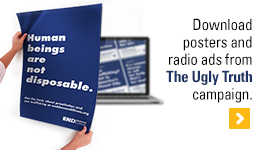Get the Facts

What is Human Trafficking?
Human trafficking is a form of modern-day slavery where perpetrators profit from the sexual exploitation and/or forced labor of men, women and children. It is a violation of basic human rights, and it is also a crime as defined by U.S. federal law and California state law.
Sex trafficking is the exploitation of a person by means including force, fraud, coercion or deceit to engage in commercial sexual activity such as prostitution, exotic dancing, or pornography. Commercial sexual activity is the exchange of sexual activity for something of value like money, food, shelter or drugs.
When the victim is a minor under the age of 18-years old, sex trafficking does not require force, fraud or coercion. Minors cannot legally consent to sexual activity.
- Human trafficking is not a choice. A person cannot consent to become enslaved.
- Human trafficking is different than smuggling. Smuggling is based on transportation; trafficking is based on exploitation (although the two can occur together).
- Human trafficking does not require that a victim be moved over state or international borders. Human Trafficking is also a domestic issue inside CA state and San Diego County.
- 27 million people are trafficked each year worldwide, with approximately 18,000 victims in the U.S. (U.S. Department of State)
- Human trafficking is one of the most profitable criminal enterprises with estimates of profit worldwide of $32 billion, and 9.5 billion annually in the U.S.
- California, a populous border state with a significant immigrant population is one of the nation’s top four destination states for trafficking of human beings.
- San Diego was identified by the FBI as of the top 13 high intensity child prostitution areas.
- Human Trafficking that is based in sexual exploitation and its related forms of pimping and pandering form the majority of criminal prosecutions.
- Victims of human trafficking include children, women and men.
- Victims of human trafficking can be domestic or foreign to include U.S. citizens and legal residents, or foreign nationals including those legally documented or undocumented.
- Victims regularly include runaway youths solicited and recruited for prostitution and other forms of sexual exploitation. Minors who are runaways, truant from schools and involved in foster care are at the highest risk of becoming a victim of sex trafficking.
- Victims often have backgrounds of child physical or sexual abuse/domestic violence, but do span every socioeconomic and family background.
A perpetrator of Human Trafficking is any person who alone or by working with others:
- Attempts to induce or persuade a child or minor under the age of 18 to engage in prostitution, pornography or other forms of sexual exploitation.
- Deprives or violates the personal liberty of anyone 18 or above through means including coercion, duress or deceit to engage the victim in prostitution, pornography or other forms of sexual exploitation.
- Deprives or violate the liberty of anyone under or over the age of 18 through means including coercion, duress or deceit to obtain forced labor or services.
- Perpetrators include family members, boyfriends, peer recruiters and organized criminals and gangs.
San Diego County is committed to the combat of Human Trafficking in all its insidious forms of sex, labor or both through the U.S. and CA Department of Justice 4 Ps model of: Prevention, Protection, Prosecution and Partnerships. Here are a few examples:
- San Diego County Regional Human Trafficking and Commercial Sexual Exploitation of Children Advisory Council. This Council authorized by the Board of Supervisors in 2011 is a multi-disciplinary council that provides evidence based recommendations for best practices in our region. It has the following working subcommittees: Child Welfare, Education, Community, Prosecution, Law Enforcement, Victim Services, Survivor Voice and Research-Data.
- San Diego Human Trafficking Task Force. This is a regional State, Local and Federal Law Enforcement task force with the mission of dismantling organized human trafficking organizations and protecting victims of human trafficking through a victim centered model.
- San Diego District Attorney’s Office Sex Crimes and Human Trafficking Division. This is a division of specialized and highly trained prosecutors, investigators, victim advocates and paralegals that handle these special victim cases with the goal of holding perpetrators accountable and treating victims with dignity and respect. (The U.S. Attorney’s office also has a dedicated team to federally prosecute human trafficking.)
- Child Welfare Steering Committee on Commercial Sexual Exploitation of Children. This is a multi-disciplinary steering committee lead by Child Welfare that works on protocols and initiatives that are evidence based to address this most vulnerable child population.
- Unity Coalition with BSCC, PCI and the CEASE network. In addition to victim services, these organizations focus on the Demand side of Sex Trafficking where the criminal buyers are substantially responsible for the continued exploitation of men, women and children that are prostituted or commercially exploited.
- There are about 3,417 to 8,108 trafficking victims per year in San Diego county.
- The average age of entry into sex trafficking is 16.
- About 80 percent of victims in San Diego County are from the United States.
- All 100 percent of high schools that participated in a recent study reported recruitment of their students for sex trafficking.
- About 90 percent reported cases of their students becoming victims of sex trafficking.
- Homeless and foster youth are at the greatest risk for recruitment.
- About 85 percent of sex trafficking is controlled by more than 100 gangs.

